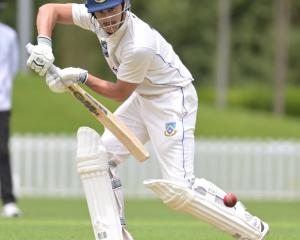The University Oval has slipped down the batting order since the arrival of Hagley Oval as an international venue. Will it slide further? Cricket writer Adrian Seconi examines the competition.
It was comfortably the leading test venue in the South Island and arguably the country's No 2 ground.
The big boys, South Africa and England, played a test here in 2012 and 2013 and the Pakistan, Sri Lanka and Bangladesh teams all visited our fair city.
The West Indies came twice.
Last season was an extremely busy time for the venue. It hosted two one-day internationals against Sri Lanka and three World Cup games.
In all, the University Oval has hosted seven tests and seven ODIs since making its international debut in January 2008.
The steady stream of international cricket helped justified the money poured into the venue.
It was cricket nirvana for the deep south.
But there was also a feeling a lot of the games were being scheduled here by default.
Until Hagley Oval emerged as an international venue in January 2014, there was really nowhere else in the South Island to play test cricket.
The University Oval's monopoly grip on those test matches was broken.
It suddenly had competition and once more it was at a considerable disadvantage.
Hagley Oval is every bit as beautiful.
It is located in the leafy Hagley Park and the playing surface is surrounded by large grassy embankments which can support 8000-9000 spectators.
The pitch is rated as the best in the country.
It has pace and bounce and produces results.
The University Oval has a capacity of 3500, though 3000 is probably more realistic.
That capacity can be extended to 5000 with some temporary seating, which comes at an additional cost.
The Black Caps are undefeated at the University Oval but taking 20 wickets on the surface has proved a challenge.
It is often low and slow.
Dunedin's dearth of quality accommodation and lack of flights in and out of the city is another hurdle for the venue.
The Otago Cricket Association launched an ambitious $2million-plus plan in April to install lights and expand the embankments at the venue.
But earlier this month it was forced to put the lights project on hold indefinitely and focus on lifting the venue's capacity to 6000.
"We went back and had a good discussion with NZC about future allocation of international fixtures,'' OCA chief executive Mike Coggan said when he explained the decision at the time.
"It became difficult to understand how we were going to be able to fulfil the demand that these lights were supposed to service.''
"Without 6000 capacity, we are not in a position to bid for meaningful international cricket through to 2018, so that is a real genuine priority.''
There it is in a nutshell.
It is a downgrade.
The University Oval's brief reign is over.
The venue now appears only suitable for tests against second tier nations and possibly the odd one-dayer when teams like Bangladesh are touring.
That's our lot, unless $700,000 is spent to upgrade the embankments which will increase the capacity to the required 6000.
Even then, the University Oval will still lag behind the country's leading venues.
The Basin Reserve in Wellington remains the premier test venue in the country.
It has a wonderful history and tradition.
It is where Brendon McCullum scored 302 to save a test against India and where Martin Crowe made his famous 299.
Hagley Oval and Hamilton's Seddon Park are the next two on the list.
Hagley Oval is a picturesque venue but the merits of Seddon Park are not quite as obvious.
Is a nice enough but its big advantage is probably its location.
It is about 90 minutes or so drive from Auckland and Auckland does not have a suitable test venue.
Eden Park is more of a last resort.
There was a great atmosphere at Eden Park for the Cricket World Cup semifinal but it would look empty for a test.
And you need grass, not plastic seats, to spread out on if you going to spend all day watching the sport.
That leaves the University Oval and McLean Park competing for the scraps.
McLean Park has a larger capacity, better weather and the pitch is usually quick and bouncy.
The competition for one-dayers is more intense.
The emergence of Bay Oval, Saxton Oval and Cobham Oval along with established limited-overs venues like Westpac Stadium and Queenstown Events Centre, means New Zealand Cricket has a lot of options.
Mount Maunganui's Bay Oval is perhaps the most test-ready of the newcomers.
But whether it is allocated a five-dayer soon or not may depend on how hard the Northern Districts Cricket Association pushes.
It already has two other international venues in Seddon Park and Cobham Oval.
If Bay Oval gains test status, the University Oval could find itself slipping down the order another spot.
Bay Oval has a capacity of about 8000.
Mount Maunganui is a popular holiday spot and the area enjoys good weather.
It would be an ideal venue for early-season tour games.
The Queenstown Events Centre seems to have fallen back in the pecking order, as well.
It got a regular ODIs during the traditional holiday period from 2003 to 2008 but some bad weather and poor crowds perhaps contributed to the allocation of fewer games.
But until the University Oval lifts its capacity, the Queenstown Events Centre remains Otago's best chance of luring an ODI against a decent opponent.












